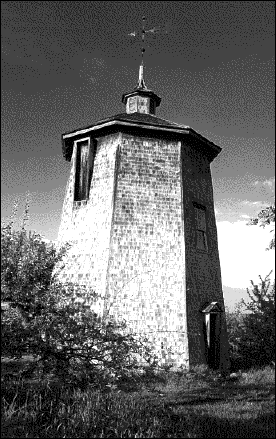Architecture
Of the
Shakers
Julia Nicoletta
(Countryman Press)

- if painted at all, should be of a dark hue, either red or brown, lead color, or something of the kind, unless they front the road, or command a sightly aspect, and then they should not be of a very light color.
Starting in the late 18th Century, Lee and her followers set up a dozen or so communities in the Eastern United States, spreading, later, as far west as Indiana and as far south as Florida. But the celibacy rule is not a good one for propagating the faith. Most of their communities --- in places as far afield as Sodus Bay, New York, Whitewater, Ohio, and Narcoosee, Florida --- died out, leaving us with but one, in Sabbathday Lake, Maine.
To those who study it from afar, what is most attractive about Shakers is the humility of their world --- in their lives, in their surroundings. Buildings were of clean lines, the furniture elegant in its simplicity, the tools --- for cooking, for the shops --- plain, and utilitarian.
The Architecture of the Shakers is divided into twelve chapters --- including" "Dwelling Houses," "Meeting Houses," "Barns, Stables and Sheds," "School Houses," and even "Laundry Buildings." There are over 125 photographs, and they are enough to take your breath away. Not only do the structures harken back to a simpler time --- the architectural lines are a perfect reflection of the soul of a people who wanted merely to live simply, work hard, and worship in peace. Of course, part of the romance is in the photographs: nothing out of place, all buildings --- brick, shingles, wood, or stone --- in harmony and in perfect, if slightly time-worn, condition.
Which is as it should be. A gorgeous volume like this captures us through sentiment --- makes us harken back to a time when people weren't murdering each other nightly on television, or indulging in drive-by shootings; a time when the sky was blue, not brown, and when you and I could ask neighbors for a cup of sugar without their thinking of us a rapists or free-loaders.
It was a time when those interested merely in being left alone to pursue their own vision of the divine weren't labelled "cultists;" when someone who built chairs or tables would not be thinking about selling them next week on the Internet. A time when individuals could set up a forge or a mill and not have to worry about a neighbor squealing on them for operating a business in a place zoned residential. It was a time when the United States could be proud of its religious freedom, a time when it was unnecessary to call in the Supreme Court to decide whether our schools were rightly defining our gods for us.
Thus The Architecture of the Shakers astonishes us, as it is no doubt meant to do, with the divine grace of a simple people in pursuit of their simple lives. It thus becomes a quiet commentary --- one which forces us to think how far we have gone from such simplicity and trust; and makes us suspect, with regret, that we may never see the grace of such folk again in this lifetime.